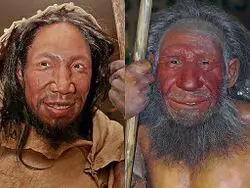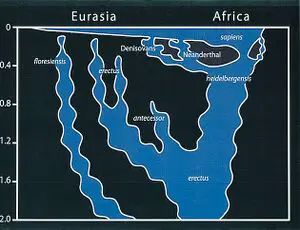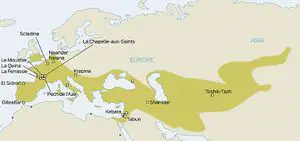Who were the Neanderthals
The study of human history, often termed “historiography,” is technically the study of the past through primary documents and sources. Although those primary sources can include art and architecture, they are most often written documents, including religious texts, annals and other historiographical records, and administrative records just to name a few. According to scholars, anything before the dawn of human civilization and writing, which roughly coincides with 3,100 BC, is considered “pre-history.” But obviously history was being made before 3,100 BC, so it too is studied, but with different methodologies, tools, and by a different set of scholars.
Where historians and archaeologists piece together humanity’s history from 3,100 BC to the present, “pre-history,” if such as term is even applicable in any circumstance, is the purview of anthropologists and archaeologists. Although anthropologists and archaeologists who study prehistoric humanity utilize the scientific method in their approach, much of what they do, and the conclusions they develop, are theoretical. “Evolutionary theory” is specifically referred to as such because the categorization of various pre-modern human and proto-human species/races is constantly changing: new evidence is routinely uncovered that reveal the existence of new species, the relationship between known species, and the uniqueness, or not, of other species. With that said, similar to standard historical studies, the era closest to the present tends to be more firmly based in fact.
What is known about prehistoric “history,” is that several different human and proto-human species that did exist, often contemporaneously and in the same geographic location, although their genetic relationships are still not completely known. Early modern humans in Europe, often referred to as Cro-Magnon, overlapped in chronology and often shared the same space with the Neanderthals. Although the Cro-Magnons eventually overtook the Neanderthals, the Neanderthals were the dominant species in Europe for thousands of years.
Contents
[hide]The First Europeans
Homo neanderthalensis, usually just known by the abbreviated term “Neanderthal,” inhabited the Earth, primarily in Europe, but also parts of Asia and north Africa, from about 400,000 to 30,000 years ago. They were once thought to have been the final step in the evolutionary ladder, but today anthropologists believe that although closely related to modern humans, with some modern Europeans and Asians having 1% to 4% Neanderthal DNA, they were not direct ancestors. Research now indicates that the Neanderthals emerged from a common ancestor not long before modern humans and can be specifically tied to a cave in Spain about 400,000 years ago. After emerging as a distinct species, the Neanderthals demonstrated superior intelligence, which was seen in their advanced tool making culture, allowing them to be the dominant species in Europe and parts of Asia for more than 200,000 years.
Homo-erectus and Homo-heidelbergensis
Before the Neanderthals roamed across Europe and parts of Asia, Homo-erectus was the dominant hominin species on Earth. It first appeared in Africa about two million years ago and lived until at least 108,000 years ago. Scholars was once thought that Neanderthals and modern humans directly evolved from Homo-erectus, although that hypothesis has been challenged in recent years. Neanderthals and modern humans may be directly descended from Homo-erectus, but it may also be that they are just closely related and from collateral branches of the same family tree. [1] The common ancestor of the Neanderthals and modern humans is now believed to have been a sub-species of Homo erectus that many anthropologists now argue was a completely unique species of homo.
As Homo-erectus emerged from Africa and spread across Asia and Europe, a subspecies emerged about 600,000 years ago, now known as Homo-heidelbergensis, which lived until about 250,000 years ago. Homo-heidelbergensis is so named because it was first discovered in a sand quarry near Heidelberg, Germany in 1907. [2]
As already stated, the relationship between Homo-heidelbergensis and Homo-erectus is not entirely clear, although Klein and many other leading anthropologists now believe that heidelbergensis descended from erectus but ultimately formed its own branch, leaving Africa about 700,000 to 600,000 years ago, eventually becoming the common ancestor of Homo sapiens (modern humans) and Homo neanderthalensis (Neanderthals). [3] Once in Europe, Homo-heidelbergensis quickly changed, relatively speaking, to give birth to the Neanderthals.
Sima de los Heuso Cave
The cave known as Sima Dde los Heuso at the Atapuerca archaeological site in Spain has yielded an incredible number of hominin remains that have shed new light on the emergence of the Neanderthals. Several Homo-heidelbergensis fossils were discovered at the site, with 430,000 year old bones possibly representing the earliest Neanderthals, or a transitional species between heidelbergensis and Neanderthal. It was after this point when the Neanderthals completely diverged and began spreading across Europe. [4]
As the Neanderthals spread across Europe and parts of Asia, they began leaving their material culture behind, which is how they were given their current name: they were first discovered in 1856 when quarry workers discovered a skullcap and postcranial bones in a cave in the Neander Valley near Dusseldorf, Germany. Today there are more than 350 extant samples from seventy archaeological sites, which may not seem like much, but it has helped scholars recreate the emergence and movements of this early human species. [5]
Spanning Across Europe
If the Neanderthals were alive today, few would doubt their status as humans, although they would certainly look quite different than any human currently walking the Earth. The Neanderthals were generally short, robust, heavily muscled people with broad, thick chests and long skulls and faces, they adapted well to the cold, harsh climate of Paleolithic Europe.
Although popular depictions have often portrayed the Neanderthals as more ape than human in their gait, based on skeletal reconstructions anthropologists now believe their posture was for the most part modern. [6] These physical features played a major role in the Neanderthals migrations and dominance in Europe and into Asia during the late Lower Paleolithic Period (three million to 300,000 years ago) and the Middle Paleolithic Period (300,000 to 30,000 years ago).
The Neanderthals’ migration across Europe was a very slow process that took tens of thousands of years. During the late Lower Paleolithic Period, it is estimated that there were probably only a few hundred Neanderthals living in Europe, mostly in small groups of no more than a dozen people, following game and living in caves. [7] By the time of the early Upper Paleolithic Period (50,000 to 30,000 years ago for the Neanderthals, although the period continued until about 12,000 years ago), their numbers had increased to about 40,000. [8] In addition to possessing physical attributes that were conducive to survival in Paleolithic Europe, the Neanderthals were more intelligent and innovative than their hominin predecessors.
Although Homo-erectus and Homo-heidelbergensis were tool creating and using hominins, the Neanderthals brought tool making to a more sophisticated level in the Middle Paleolithic Period by introducing what is now known as the Mousterian Industrial Complex. Named for a cave in Le Moustier, France, the Mousterian Industrial Complex represents the peak of Neanderthal activity and the major reason why they were able to become the dominant species in Europe for such a long period. Mousterian tools are noted for being made of flint, particularly by using the Levallois technique, which involved the knapping procedure whereby arrowheads and other tools were chipped away from a bigger piece. [9] Once Neanderthal groups made their tools, they used them to hunt game, make clothing, and protect themselves from animals and other hominins. The creation of the Mousterian tools clearly shows that the Neanderthals were much smarter than hominins before them, but their organizational skills were also superior. Using stone-tipped thrusting spears they made using the Levallois technique, Neanderthals hunted big game in groups, although they still had to get close, which often resulted in severe injuries and fatalities. [10]
Conclusion
The Neanderthals dominated Europe and parts of Asia for hundreds of thousands of years, much longer than modern humans have even existed. The anthropological and archaeological evidence shows that although the Neanderthals are related to modern humans, and many people of European and Asian descent carry Neanderthal DNA, they were a distinct species of humans. Despite the origins of the Neanderthals still being a bit murky and open to debate, it appears that they separated from Homo-heidelbergenesis around 400,000 years ago in Spain. Over the course of thousands of years, the Neanderthals developed a sophisticated tool-making culture and organizational skills that allowed them to dominate Europe until they became extinct towards the end of the Paleolithic Period. Evidence shows, though, that modern humans owe a debt of gratitude to the Neanderthals for laying the groundwork in advanced tool-making culture.
References
- Jump up ↑ Fergusson, Kennan. “What Was Politics to the Denisovan?” Political Theory 42 (2014) p. 170
- Jump up ↑ Klein, Richard G. The Human Career: Human Biological and Cultural Origins. Third Edition. (Chicago: University of Chicago Press, 2009), p. 311
- Jump up ↑ Klein, p. 280
- Jump up ↑ Klein, p. 311
- Jump up ↑ Klein, pgs. 437-440
- Jump up ↑ Klein, p. 450
- Jump up ↑ Rogers, Alan R., Ryan T. Bohlender, and Chad D. Huff. “Early History of Neanderthals and Denisovans.” Proceedings of the National Academy of Sciences of the United States of America 37 (2017) p. 9862
- Jump up ↑ Hawks, John. “Significance of Neandertal and Denisovan Genomes in Human Evolution.” Annual Review of Anthropology 42 (2013) p. 442
- Jump up ↑ Klein, pgs. 481-9
- Jump up ↑ Klein, p. 551



